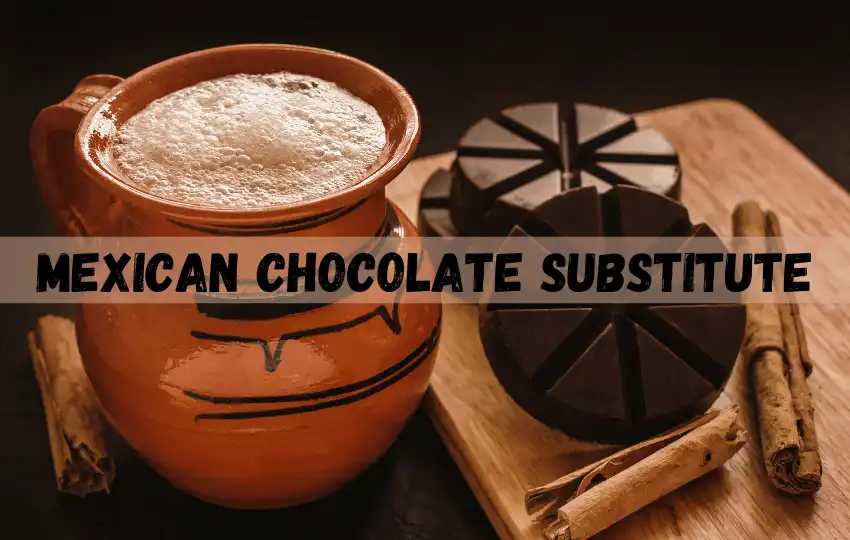Mexican chocolate is a well-known ingredient in many dishes, especially when it comes to desserts. It is sweet, spicy, and aromatic, and it can truly elevate any recipe.
Have you ever had a recipe that called for Mexican chocolate, but you didn’t have any on hand? Don’t worry; we’ve got you covered!
In this post, we will share 10 ideal Mexican chocolate substitutes with ratios and how to use the alternatives.
We understand that sometimes it can be tough to find authentic Mexican chocolate, but we promise that these substitutes will work just as well, and they might even become your new go-to ingredients.
In short, " What can I use instead of Mexican chocolate?" Cocoa Powder and Cinnamon, Dark Chocolate and Cinnamon, Cocoa Powder, Sugar, and Chili Powder, Semi-Sweet Chocolate and Cinnamon, Dark Chocolate, Sugar, and Chili Powder, Cacao Nibs, Unsweetened Chocolate, Sugar, and Cinnamon, and many more.
What is Mexican chocolate, and what does Mexican chocolate taste like?
Mexican chocolate is a traditional type of chocolate used in Mexican cuisine, made with cocoa beans, cinnamon, vanilla, and sugar.
It has a rich and intense flavor that is sweet but slightly spicy due to the use of chili peppers or other spices.
Mexican chocolate also has a creamy texture because it is ground into a fine paste before being molded into bars or disks.
Its unique flavor makes it ideal for making hot chocolate drinks as well as desserts like flan or cookies.
Uses of Mexican chocolate
Mexican chocolate is a unique and versatile type of cocoa product that has both culinary and medicinal uses.
In Mexico, it is commonly used for preparing hot chocolate drinks, sweet treats, and even savory dishes like mole sauce.
It’s also a popular choice for adding depth and flavor to classic Mexican dishes like pozole.
Additionally, almonds provide vitamin E, which helps guard cells from harm caused by free radicals.
In addition to its culinary applications, Mexican chocolate can be used medicinally too.
For example, some people have found relief from common flu symptoms after drinking hot Mexican chocolate made with honey or agave syrup.
Others swear by its ability to soothe an upset stomach when consumed with mint leaves or ginger root.
Finally, some claim that its natural sedative qualities can aid in relaxation before bedtime or during times of stress.
Clearly, there is a range of uses for Mexican chocolate, from adding delicious flavor to meals to providing therapeutic benefits.
It’s no wonder why this special type of cocoa has become such a popular choice throughout Mexico!
What makes Mexican chocolate different?
Mexican chocolate is distinct from other types of chocolate due to its unique flavor profile. It differs from traditional chocolate in a few key ways.
One main difference lies in its texture, which is often grainy or sandy due to the addition of cinnamon, sugar, and ground almonds.
Mexican chocolate also has a much stronger flavor than traditional chocolate, as it contains added spices such as chili peppers, cayenne pepper, nutmeg, and vanilla that give it an earthy taste.
The combination of cocoa beans and other ingredients, such as nuts and spices, makes this type of chocolate a popular choice for desserts like flan de leche and churros con chocolate.
Additionally, Mexican chocolate can be used for baking or melted down into a rich sauce perfect for bread pudding or drinking hot on its own.
Where to buy Mexican chocolate?
If you are looking for where to buy Mexican chocolate, there are a few different places you can go. Many specialty food stores carry it, as do some international grocery stores.
You can also order online from many retailers that provide a variety of diverse flavors and types of Mexican chocolate.
Best Mexican chocolate substitutes
1. Cocoa Powder and Cinnamon – a good Mexican chocolate substitute
Cocoa powder and cinnamon are a great alternative to Mexican chocolate.
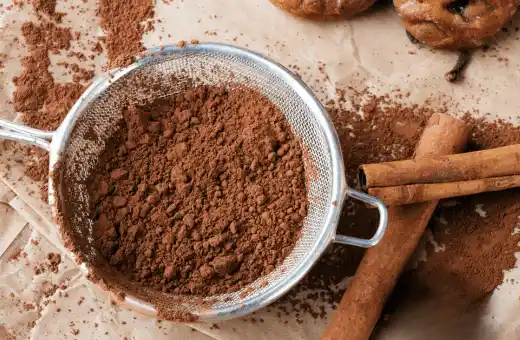
Ratio or measurement: Mix 1 cup of unsweetened cocoa powder with 2 teaspoons of cinnamon to replace 4 ounces of Mexican chocolate.
You can use this in your baking recipes or to make hot chocolate.
2. Dark Chocolate and Cinnamon – similar to Mexican chocolate
If you have dark chocolate on hand, you can use it instead of Mexican chocolate.
Ratio or measurement: Melt 4 ounces of dark chocolate and mix it with 2 teaspoons of cinnamon.
Use this mixture in your recipes. You can also grate the chocolate and use it as a topping for your desserts or sprinkle it on your hot chocolate.
3. Try Cocoa Powder, Sugar, and Chili Powder in place of Mexican chocolate
To get the spice and sweetness of Mexican chocolate, use a combination of cocoa powder, sugar, and chili powder.
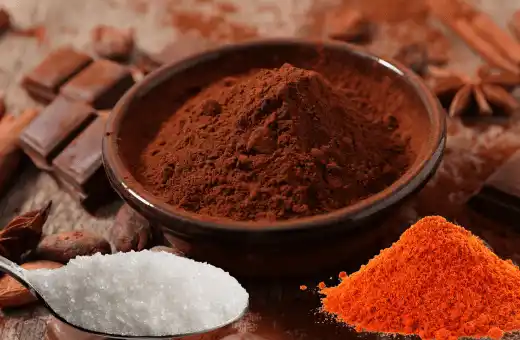
Ratio or measurement: Mix 1 cup of unsweetened cocoa powder with 1 cup of sugar and 1 teaspoon of chili powder to replace 4 ounces of Mexican chocolate.
This is perfect for making spiced brownies or chocolate sauce.
4. Semi-Sweet Chocolate and Cinnamon – similar to Mexican chocolate
Semi-sweet chocolate is another chocolate that can be used as a Mexican chocolate substitute.
Ratio or measurement: Melt 4 ounces of semi-sweet chocolate and mix it with 2 teaspoons of cinnamon.
Use this mixture in your recipes. You can also use this chocolate as a topping or in your hot chocolate.
5. Dark Chocolate, Sugar, and Chili Powder – a tasty Mexican chocolate alternative
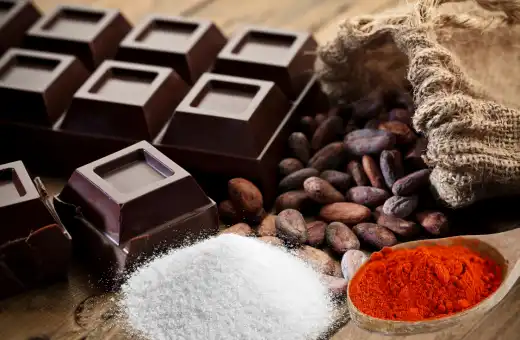
For a sweeter alternative to Mexican chocolate, use a combination of dark chocolate, sugar, and chili powder.
Ratio or measurement: Melt 4 ounces of dark chocolate and mix it with 1 tablespoon of sugar and 1 teaspoon of chili powder.
Use this mixture in your recipes. This is a great topping for ice cream and can also be used in hot chocolate.
6. Cacao Nibs – similar to Mexican chocolate
Cacao nibs are little pieces of roasted cacao beans with a crunchy texture and a rich chocolate flavor.
They can be used as a substitute for Mexican chocolate in desserts or as a topping.
Ratio or measurement: Use 4 tablespoons of cacao nibs to replace 4 ounces of Mexican chocolate.
7. You can use Unsweetened Chocolate, Sugar, and Cinnamon instead of Mexican chocolate
Unsweetened chocolate can also be used to substitute Mexican chocolate.
Ratio or measurement: Melt 4 ounces of unsweetened chocolate and mix it with 1 tablespoon of sugar and 2 teaspoons of cinnamon.
Use this mixture in your recipes. You can also use this chocolate as a topping for your desserts.
8. Semi-Sweet Chocolate Chips – similar to Mexican chocolate
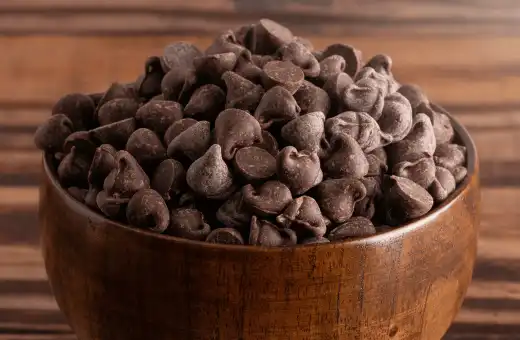
Semi-sweet chocolate chips are a great substitute because they are sweetened and have a high percentage of cocoa solids.
They have a similar texture to Mexican chocolate and can be easily melted down.
Ratio or measurement: For the perfect ratio, use 2 ounces of semi-sweet chocolate chips for every 1 ounce of Mexican chocolate.
9. Chilies and Unsweetened Cocoa Powder – a great Mexican chocolate replacement
If you want to add some heat to your recipe, then chilies and unsweetened cocoa powder are a great substitute for Mexican chocolate.
The chilies add spice, and together with the cocoa powder, the combination mimics the flavor of Mexican chocolate.
Ratio or measurement: To make this substitution, use one tablespoon of chili powder and two tablespoons of cocoa powder for every 1 ounce of Mexican chocolate.
10. Nutella – similar to Mexican chocolate
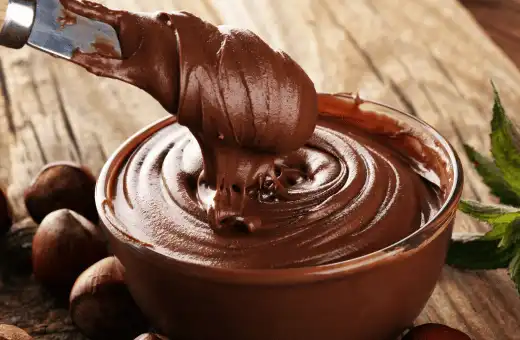
Nutella is a delicious and easy substitute for Mexican chocolate.
It has a similar texture and sweetness and can be used in any recipe that calls for Mexican chocolate.
Ratio or measurement: For the perfect ratio, use 2 tablespoons of Nutella for every 1 ounce of Mexican chocolate.
Discover more: Best Creme de Menthe Substitutes
Tips on How to Choose the Most Suitable Substitution Option for Mexican Chocolate
When selecting a suitable substitution option for Mexican chocolate, consider the following tips:
1. Dark chocolate: Mexican chocolate typically has a rich, slightly bitter flavor with hints of spices. Dark chocolate with a high cocoa percentage can be a good substitute.
Look for dark chocolate bars or chips that contain a similar cocoa content to Mexican chocolate.
2. Cinnamon and spices: Mexican chocolate often includes spices like cinnamon. If you’re using plain dark chocolate as a substitute, consider adding a small amount of ground cinnamon or other
Mexican spices, such as chili powder or nutmeg, mimic the flavor profile of Mexican chocolate.
3. Sweetness level: Mexican chocolate is often sweetened, so consider adjusting the sweetness of your substitute accordingly.
If your dark chocolate is unsweetened or less sweet than Mexican chocolate, you may need to increase the amount of sugar in your recipe to achieve the desired level of sweetness.
4. Texture: Mexican chocolate is typically sold in solid disk or tablet form, whereas chocolate bars or chips are commonly used as substitutes.
If you prefer the texture of Mexican chocolate in your recipe, you can chop or grate the chocolate substitute to mimic the coarse texture of Mexican chocolate.
5. Brand and quality: Mexican chocolate brands like Ibarra or Abuelita are specifically formulated for traditional Mexican recipes.
If you want an authentic flavor, try to find these brands or other reputable Mexican chocolate brands that are known for their quality and taste.
6. Allergies and dietary restrictions: Consider any allergies or dietary restrictions when choosing a substitution.
Look for Mexican chocolate substitutes that are free from allergens or meet specific dietary requirements, such as dairy-free or sugar-free options.
7. Taste testing: Experiment with different brands and types of chocolate to find a substitute that closely matches the flavor profile of Mexican chocolate.
Taste testing various options can help you determine the best substitution for your specific recipe.
Conclusion on Mexican chocolate substitute
There are many alternatives to Mexican chocolate that you can use in your recipes.
You can use cocoa powder and cinnamon, dark chocolate and cinnamon, cocoa powder, sugar, and chili powder, semi-sweet chocolate and cinnamon, dark chocolate, sugar, and chili powder, cacao nibs, and unsweetened chocolate, sugar and cinnamon.
Use these substitutes and get the same sweet, spicy, and aromatic flavor in your dishes. Enjoy trying out these Mexican chocolate substitutes, and let your creativity soar in the kitchen.
FAQs on Mexican chocolate substitute
Q1. What is similar to Mexican chocolate?
Mexican chocolate has a unique flavor that is similar to traditional dark chocolate but with some subtle differences.
It typically contains a blend of spices such as cinnamon, nutmeg, and cayenne pepper, giving it an earthy taste that sets it apart from other types of chocolate.
Other variations may include almonds, raisins and even coffee beans for added flavor.
Common substitutes for Mexican chocolate are dark or semi-sweet European chocolates that have been blended with spices like cinnamon or nutmeg to mimic the unique flavors of Mexican chocolate.
Q2. Can I use dark chocolate instead of Mexican chocolate?
Yes, you can use dark chocolate instead of Mexican chocolate. Dark chocolate has a rich, velvety texture and intense flavor that is far more flavorful than Mexican chocolate.
Additionally, dark chocolate has more cocoa solids which will provide a deeper flavor and more intense sweetness than Mexican chocolate.
Dark chocolate also tends to have less sugar than Mexican chocolate, so if you’re looking for a healthier option, dark chocolate is the way to go.
Q3. What tastes exactly like chocolate but isn’t?
There are a few options that may taste similar to chocolate but are not actually chocolate. Here are a few examples:
1. Carob: Carob is a fruit native to the Mediterranean region. Its powder, often used as a chocolate substitute, has a sweet and earthy flavor that some people find similar to chocolate.
2. Cacao Nibs: Cacao nibs are small pieces of crushed cacao beans. While they come from the same plant as chocolate, they are not sweetened or processed like chocolate bars.
Cacao nibs have a rich, slightly bitter taste that resembles dark chocolate.
3. Cocoa Powder: Cocoa powder is made by grinding roasted cacao beans. It is commonly used in baking and hot chocolate drinks.
Unsweetened cocoa powder has a strong chocolate flavor and can be used as a substitute for chocolate in certain recipes.
4. Chocolate-Flavored Products: There are also various chocolate-flavored products available in the market that aim to mimic the taste of chocolate without actually containing it.
These products often use artificial flavors or natural flavorings to create a chocolate-like taste.
Q4. What is the best substitute for chocolate?
The best substitute for chocolate is carob. Carob is a naturally sweet, cocoa-like powder made from the pods of an evergreen Mediterranean shrub.
Unlike chocolate, carob does not include caffeine or theobromine, making it a good choice for those sensitive to either stimulant.
Carob also contains three times more calcium than cocoa and can be used in baking as a one-to-one substitution for cocoa powder. Additionally, carob is fat-free and has fewer calories than chocolate.

